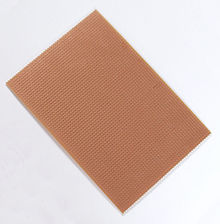
Back স্ট্রিপবোর্ড Bengali/Bangla Stripboard Catalan Leiterplatte#Prototypen German بردنواری Persian Reikäpiirilevy Finnish Veroboard French Basetta millefori Italian Nulinė plokštė Lithuanian
This article needs additional citations for verification. (May 2008) |

 Veroboard piece | |
| Product | Electronic component |
|---|---|
| Inventor | Terry Fitzpatrick |
| Company | Vero Electronics Ltd |
| Country | UK |
| Availability | 1960 - present |
Stripboard is the generic name for a widely used type of electronics prototyping material for circuit boards characterized by a pre-formed 0.1 inches (2.54 mm) regular (rectangular) grid of holes, with wide parallel strips of copper cladding running in one direction all the way along one side of an insulating bonded paper board. It is commonly also known by the name of the original product Veroboard, which is a trademark, in the UK, of British company Vero Technologies Ltd and Canadian company Pixel Print Ltd. It was originated and developed in the early 1960s by the Electronics Department of Vero Precision Engineering Ltd (VPE). It was introduced as a general-purpose material for use in constructing electronic circuits - differing from purpose-designed printed circuit boards (PCBs) in that a variety of electronics circuits may be constructed using a standard wiring board.[citation needed]
In using the board, breaks are made in the tracks, usually around holes, to divide the strips into multiple electrical nodes. With care, it is possible to break between holes to allow for components that have two pin rows only one position apart such as twin row headers for IDCs.
Stripboard is not designed for surface-mount components, though it is possible to mount many such components on the track side, particularly if tracks are cut/shaped with a knife or small cutting disc in a rotary tool.
The first single-size Veroboard product was the forerunner of the numerous types of prototype wiring board which, with worldwide use over five decades, have become known as stripboard.[citation needed]
The generic terms 'veroboard' and 'stripboard' are now taken to be synonymous.[citation needed]